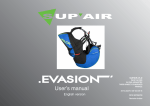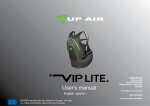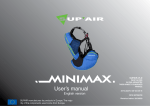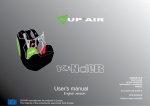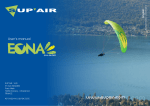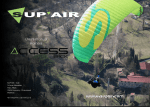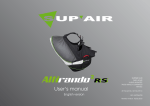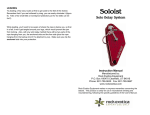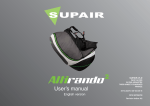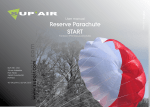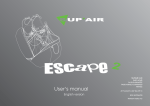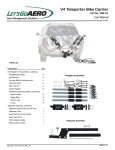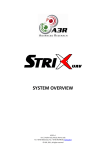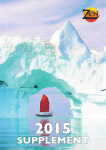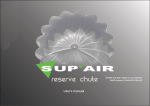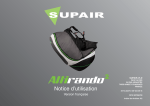Download User`s manual
Transcript
SUPAIR-VLD User’s manual English version PARC ALTAÏS 34 RUE ADRASTÉE 74650 ANNECY CHAVANOD FRANCE 45°54.024’N / 06°04.725’ E RCS 387956790 Revision Indice Thank you for your choice of a WALIBI². We are proud to join you on your journey in our common passion : paragliding. SUP’AIR has been designing, producing and selling accessories for free flying activities since 1984. By choosing a SUP’AIR product you benefit from almost thirty years of expertise, innovation and listening. This is also our philosophy : working endlessl We trust that you will find this user’s manual comprehensive, explicit and hopefully pleasant to read. We advise you to read it carefully ! On our website www.supair.com, you will find the last up to date information about this product. If you have any further questions, feel free to ask one of our retailers. And of course, the entire SUP’AIR team are at your disposal through info@supair. com We wish you many safe flying and enjoyable hours, and happy landings The SUP’AIR team 2 List of contents 17 List of contents 3 Storage and transport Introduction4 Lifetime17 Technical specifications 5 Care17 Harness overview 6 Repair18 Components6 Materials18 Rescue parachute setup assembly. 7 Recycling18 18 Adjustable reserve parachute pocket. 8 Environmental friendly practices Reserve parachute installation in the pocket. 8 Warranty19 Installing the reserve parachute in its pocket. 9 Disclaimer19 19 Position setting 11 Pilot’s gear 20 Leaning angle setting 12 Service Book Shoulders’ straps adjustments. 12 Chest strap adjustment. 12 Flight behavior 13 Pre-Flight control 14 Take-off15 In flight 16 Landing16 Wash and care of your harness 17 Pictures credits : SUP’AIR 3 Introduction Welcome to the tandem world. With the WALIBI², you are equipped with a tandem harness designed with an integrated reserve parachute pocket and an AirBag protection. This harness is targeting intensive professional use. The split-leg design facilitates the running phase and enables the pilot to adopt an ergonomic posture with the passenger seat locked in place between his legs after takeoff. After reading this manual, we suggest you check your harness by hanging in it before flying. N.B : Three important icons will help you when reading this manual Advice Caution ! Danger !! 4 Technical specifications Pilot size A B Back height (cm) Leaning setting height (cm) C Seat length (cm) D Seat width (cm) E Carabiners height (cm) F Carabiners distance (cm) Harness weight (+ carabiners+speedbar) Designed for Back height (cm) Leaning setting height (cm) Seat length (cm) Carabiners height (cm) Impact damping system : Airbag (Volume) Impact damping system : Bumpair (Thickness) Homologation Flight : tandem (Pilot- Passenger) Flight : acrobatic flying Take-off : Winching Quick-out carabiners compatibility Taille S Taille M/L 155-175 cm 170-195 cm 3610 g 3650 g Paragliding only Parapente uniquement 58 28 40 40 Yes 68 34 47 40 Yes No No EN 1651 - LTF Pilot EN 1651 - LTF Pilot No No No No No No This harness is delivered with two 30 mm Biners ( 138 g. for the set ). 5 Components 4 Harness 2 Reserve parachute handle (W) 3 30 mm Aluminium self-locking biner 3 2 1 1 5 4 Mini Bump 5 Walibi Palte Wood Harness overview This illustration will help you during your reading. 5 1 Rectangular push-through leg straps buckles. 3 Ventral width adjustment 2 1 4 4 3 2 4 5 6 6 Automatic ventral buckle Leaning setting Shoulders straps adjustment Reserve parachute handle (W) 6 6 Rescue parachute setup assembly. Thank you for comprehensively reading the following ! We will recommend you to have your reserve parachute initially installed by someone competent and familiar with the procedure. Open the Mini-Bump zip located at the bottom of the dorsal pocket. Insert the Mini-Bump through the dorsal pocket and slide it behind the reserve parachute pocket.When done, close the Mini-Bump pocket. Connecting the handle to the rescue parachute’s deployment bag Place the handle inside the middle webbing loop and make a lark’s head knot with the handle. Fasten tightly the lark’s head knot and verify the solidity of the link. The handle must be connected to the central loop. 7 Installing the reserve parachute in its pocket. Thank you for comprehensively reading the following ! We will recommend you to have your reserve parachute initially installed by someone competent and familiar with the procedure. Adjustable reserve parachute pocket. The reserve parachute pocket volume is variable in size.You first must adjust its volume according to that of your reserve parachute. Small volume default setting. Pull on the rear flap, remove the elasticated cord from it grommet. Push the piece of line/cord, underneath the connection strap, then through the external grommet. The pocket volume can slightly be increased by using the lateral flaps external grommets. The harnesses are delivered by default, with the “small” volume setting corresponding to the X-TRALITE BI-SUP’AIR reserve Reserve parachute installation in the pocket. Insert the reserve parachute inside the harness parachute pocket by opening all the flaps. The POD must be positioned with the handle at the top with risers and lines at the bottom. Push the risers through the guiding sleeves ( the risers must be located behind the parachute ). Push the cord through the elasticated right loop ( if the handle is located to the right ). Push the elasticated loop through the lower flap grommet. The yellow cable will also be pushed through the lower flap guide located near the grommet. Push the elasticated cord through the upper flap grommet. 8 Push the yellow cable through the elasticated loop and gently pull the cord out. 8 The yellow cable locks the reserve parachute pocket flaps in place. Tuck the upper flap inside its lower stretchable pocket. Check before every fligth for the yellow cable to be properly inserted through the two elasticated loops keeping the reserve parachute pocket securely Push the cord through the elasticated left loop. 9 Position the handle in its folding sleeve. It may not protrude from the harness. Push the elasticated loop through the lower flap grommet. Push the elasticated loop through the upper grommet flap grommet and push the yellow cable through it ( elasticated loop ). 10 Handle positioning in it holding sleeve. Upon setup completion, conduct an extraction sequence during a hang-test to verify that all works properly before duplicating the installation procedure again... 9 Install the risers inside the lateral guiding sleeve. The risers come out of each strap guide. Connect the risers atop each spreader-bar ( main hooking location ), with the maillon rapide trapeze stainless steel 6 mm + the flexible elastic rings. Toward the « B « or « C « wing risers. On both sides, push the small recoil » André Rose « strap / webbing, through the main paraglider carabiner riser, and connect it to the « B « or « C « paraglider riser using a triangular ( Delta shaped ) Maillon - riser denomination can vary from manufact « André Rose « System. Parachute riser. Pilot Passenger. Pilot Passenger. 10 Position setting All harness adjustments must be made prior the first flight during a hang-test session. It is of utmost importance to adopt a proper flying posture, check all basic adjustments and have easy access to in-flight adjustments. 1 Chest strap finger-loop tension tightening adjustment. 2 Chest strap finger-loop tension release adjustment. 3 4 1 2 Tightening snapper (leaning setting) Loosening strap (leaning setting) 6 5 6 Tightening strap) snapper (shoulder 5 Loosening strap ( shoulder strap) 3 4 11 A Leaning angle setting Set the angle of leaning by tightening the snapper (towards a more vertical position) or the black webbing (towards a more horizontal position). You can extend the lumbar support by tightening the #5 buckle. B tighten loosen Shoulders’ straps adjustments. Tighten the shoulder straps by pulling the finger loop down. Pull up to release. loosen The shoulder straps support, greatly helps the comfort level. It should be set precisely. You must find the correct tension between the side and shoulder straps adjustments. tighten C Chest strap adjustment. To adjust correctly during a hang-test. The chest-strap tensioning/loosening as little effect on the wing’s incidence while weight-shifting. 12 Flight behavior The WALIBI² is a tandem harness. Its split-leg system enables the pilot to quickly adopt a comfortable seating posture with the passenger between the legs immediately after takeoff. The split-leg system facilitates the running phase as well. The following harness can also be used in solo flights. It is equipped with a split-leg self-stabilizing system buffering the overall flight handling. 13 Pre-Flight control Conduct a thorough pre-flight check before each takeoff. • • • • Check the harness and Biners integrity. Be certain for the reserve parachute pocket to be properly closed with its handle securely in place. Check that your harness adjustments have not changed. Check the connexion risers / harness as well as the self-locking Biners ( locked and secured ). Only after a thorough weather conditions analysis, can the decision to wether fly or not be taken, and outfit yourself with the harness. • Fasten and securely lock the leg and chest-strap buckles. • Double check that all buckles are fully locked and secured by pulling firmly on them. Check that no line, tab or cloth is stuck / jammed in the buckles. • Be absolutely certain for the reserve parachute handle to work freely without anything impeding its proper functioning. 14 Take-off Takeoff is a simple and straight forward. The transition from running to seating is easy. Do not push yourself inside the seat with the toggles still connected to your hands. There would be a risk of increasing the angle of attack, slowing the wing down with a possible stall taking place as a result. 15 In flight Please set the distance between the two carabiners according to the aerology and to the wing manufacturer’s recommendations. The average distance / spacing for most gliders from the center of the right Biner to the center of the left Biner where the riser Tightening the chest strap provides more stability but less harness piloting efficiency. Doing so, increases the risk of riser twisting. On the contrary, loosening the strap provides more efficiency but can be dangerous in turbulent aerology while increas Landing Stretch your legs the and adopt an upright position in order to run and dissipate horizontal speed. With a split-leg harness, adopting a standing/upright posture may feel more difficult to achieve than with a seat-plate outfitted harness. Straightening/ stretching the legs fully will Do not land whilst in the seated position, this is dangerous. 16 Care Wash and care of your harness It is a good idea to wash your harness from time to time. To do this, we recommend to use a soft solvent (such as soap), use a brush and rinse thoroughly. In any case, do not use chemicals such as detergents or strong solvent because it may deteriorate the webbing, stitching and fabrics of your harness. The zip fasteners should be lubricated from time to time, using a silicon spray. Storage and transport When you don’t use your harness, store it inside your paragliding rucksack, in a dry, cool and clean place, protected from UVs exposure. If your harness is wet, please dry it thoroughly before storing. For transport, protect the harness from any mechanical or UV deterioration (use a bag). Please avoid long transports in wet conditions. Lifetime Independently of the pre-flight check-out, you have to open and unfold your rescue parachute once every 6 months. Once every 2 years, you need to perform a complete check of your harness : Carbon seat plate : no crack, no asperity. webbings (no excessive wear, no rip beginning, no unwanted folds) buckles and carabiners ( no structural cracks / works fine ). The threads composing the webbing and fabrics used in the WALIBI LITE have been selected in order to ensure the best possible lightness/lifetime compromise. Nonetheless, in some conditions, after a long term exposure to UV and/or significant abrasion or exposure to chemicals, it is compulsory to check your harness in a certified repair centre. It is about your safety. These carabiners must never be used for anything else else than paragliding (not for climbing, no towing, etc.). Sup’air advice to replace the carabiners every 5 years. 17 Repair Though we use the highest quality materials, it is possible that your harness may eventually deteriorate through general use. If its is showing any signs of significant wear and tear, you should check it and repair it in an certified repair centre. SUP’AIR offer a repair facility for their products beyond the end of the warranty period. Please contact us either by telephone or by E-mail [email protected] in order to receive a quotation. Materials Fabrics DYNEEMA® RIPSTOP CORDURA® Recycling All our materials are selected for their technical and environmental characteristics. No components of our harnesses may harm nature. Most of our components are recyclable. If you judge your harness has finished its life, you can separate all the plastic and metallic parts and apply up-to-date sorting rules in effect in your community. For recycling of the fabric parts, we advise you to contact your local authority that deal Webbings Polyamide 20 mm (500DaN) Polyester 25 mm (1250 DaN) Environmental friendly practices We highly recommend you to respect as much as possible our environment while practicing paragliding and especially : not to go outside tracks, do not make unwanted noise and do not disturb the mountain areas’ balance. We advise you to do this starting from the take-off. 18 Warranty SUP’AIR takes the greatest care in the design and production of its products. SUP’AIR guarantees its products 5 years (from purchase date) against any defect or design fault occurring during normal use. Any damage or degradation resulting from incorrect or abusive use, abnormal exposure to aggressive factors, including, but not limited to; high temperature, intense sun exposure, high humidity etc will invalidate this warranty Disclaimer Paragliding is an activity that requires, skill, specific knowledge and sound judgement. Be careful, learn in certified schools, subscribe an adequate insurance policy as well as a flying license and make sure your skill match the conditions. SUP’AIR cannot be held responsible for your paragliding decisions or activities. This SUP’AIR product has been designed exclusively for paragliding. Any other activity such as skydiving or BASE jumping is absolutely forbidden. Pilot’s gear This is essential that you carry a helmet, suitable boots and clothing. Taking a reserve parachute suitable for your weight and correctly connected to your harness is also very important. 19 Service Book This page will help you to record all the life stages of your WALIBI² harness. Serial number : Purchase date Owner’s name Name and stamp of the shop Care Resale date Workshop’s name/ Buyer’s name Care Resale date Nom de l’atelier/de l’acheteur Care Resale date Workshop’s name/ Buyer’s name Care Resale date Workshop’s name/ Buyer’s name 20 SUPAIR-VLD PARC ALTAÏS 34 RUE ADRASTÉE 74650 ANNECY CHAVANOD FRANCE 45°54.024’N / 06°04.725’ E RCS 387956790






















